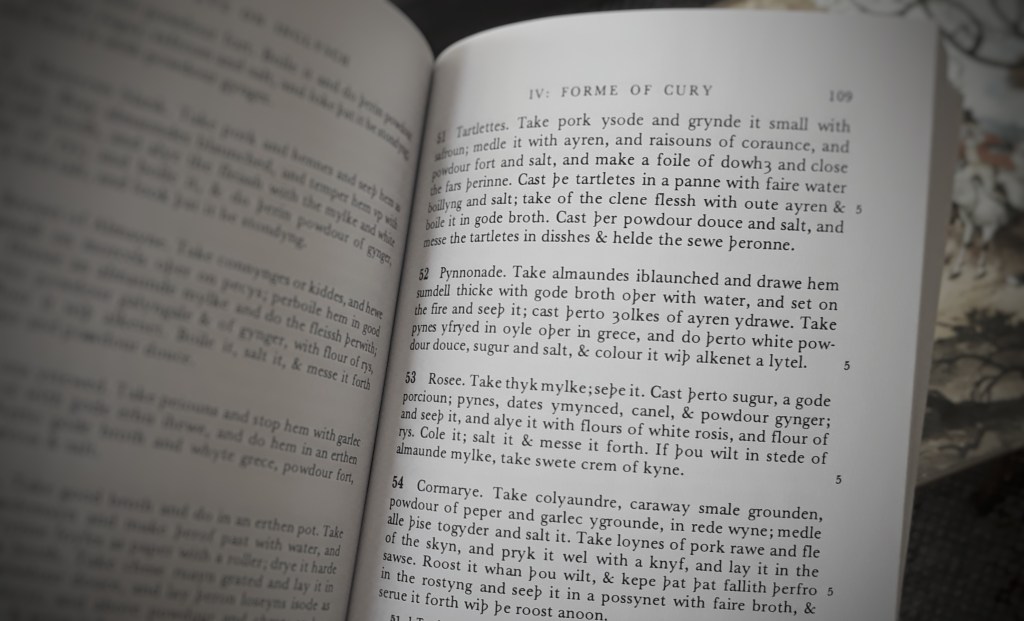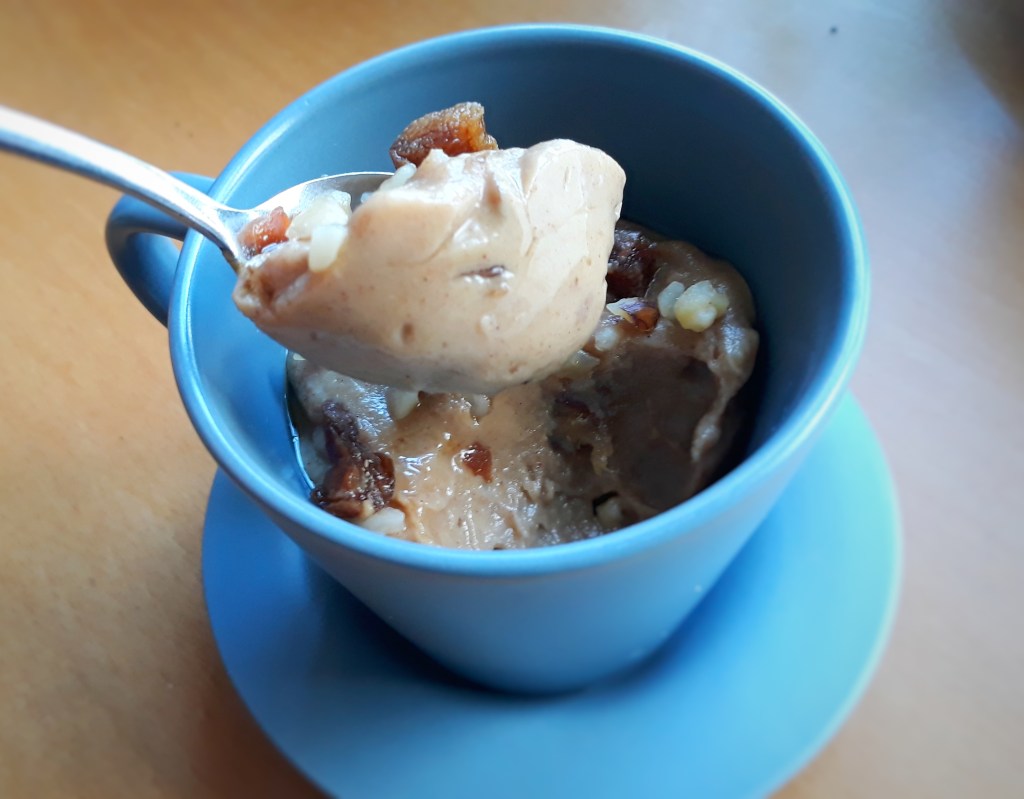
Last post I wrote about my little experiment making almond milk. With my batch I decided to make a mediaeval recipe from the first cook book in English, Forme of Cury. It was written around 1390 by the cooks of King Richard II; I’ve written about it and cooked up a few recipes from it before.
The one I chose is called Rosee, and it is like a pudding – in the American sense of the word – i.e. a thick custardy dessert. This one is thickened with rice flour instead of eggs like a regular custard and is flavoured with rose petals (“with flours of white rosis”) as well as some ginger and cinnamon. It’s not the right time of year for roses, so in lieu of the blooms, I used some rose water instead. It’s also flavoured with pine nuts and dates, which also adds a little texture. Sugar is the sweetener – which wasn’t refined to pure white in the 1400s, so I used soft light brown sugar to replicate this.
You don’t have to use mediaeval almond milk, you can buy it, or just use regular cows’ milk.

Here’s how it is written in Forme of Cury. It’s hard to decipher, but once you know the now defunct letter thorn (þ) is makes a th sound (so seþe is pronounced seethe), it makes it a lot easier.
If you like the blogs and podcast I produce, please consider treating me to a virtual coffee or pint, or even a £3 monthly subscription: follow this link for more information.
Rose Pudding 1390:
Take thyk mylke; seþe it. Cast þerto sugur, a gode porcioun; pynes [pine nuts], dates ymynced, canel [cinnamon], & powdour ginger; and seeþ I, and alye [mix] it with flours of white rosis, and flour of rys. Cole it; salt it and mess it forth. If þou wilt in stede of almaunde mylke, take swete crem of kyne [cows].
Hopefully you get the gist – it takes a while to tune in!
I didn’t follow the method exactly – I used my own cook’s logic to the dish – but I made quite a delicious pudding, and it didn’t feel as though it was a vegan dessert. A knob of butter or a glug of cream, goes a long way with making food satisfying, but I genuinely didn’t miss them. It really goes to show that the King and his court did not go without during Lent!

Rose Pudding 2019:
Makes 4 to 6 puddings
25g rice flour or cornflour
¼ tsp each ground ginger and cinnamon
250 ml mediaeval almond milk, bought almond milk or full fat milk (or a mixture)
60 g soft light brown sugar
Pinch salt
50 g chopped dates, plus extra for decoration
25 g pine nuts or chopped mixed nuts, plus extra for decoration
2 to 3 tbs rose water
Put the flour and spices in a small saucepan and whisk in the milk, starting by adding just a third of it at first to prevent lumps. When all of the milk has been added, put the pan on the heat and bring to a simmer, stirring well with a wooden spoon or small whisk as it begins to thicken. Add the sugar, salt, dates and nuts. Keep it simmering very gently for around 10 minutes to cook out the flour. If it looks like it will be too thick, add more liquid (it sets quite firm, so when it is hot, you’re looking for the consistency of thick double cream).
Remove from the heat and add the rose water – I like quite a lot, but it can be rather overpowering, so add enough that seems just right and then add a shake more. By doing this you are compensating for the fact it will be served cold, the flowery aroma less pungent.
Pour into serving cups – I went for small coffee cups – scatter with a few more dates and nuts and cover with cling film to prevent a skin forming. Pop them in the fridge until set.
Half an hour before you want to serve them, take them out of the fridge to take off the chill.

Looks fabulous. Thank you. I’ll definitely be making this, and sooner rather than later.
LikeLike
Thanks Trish! If you do make it, let me know how you get on
LikeLike
Definitely next weekend’s dessert! Thanks for the recipe and the research behind it.
LikeLike
Thanks! Let me know how you get on if you do make it.
LikeLike
Made this lovely dessert for dinner yesterday, it was delicious, and there was the added frisson of thinking about those mediaeval cooks stirring the same mixture. Next time I’m going to try and double the quantities. Thank you again for posting it.
LikeLike
Glad you made it and liked it. I get the same feeling making these medieval recipes myself…I dont even mind if the food isn’t that good, it’s the cooking it and doing just as they did that is the exciting part. If it tastes good, that’s just a bonus!
LikeLike
An English rose!
I made ajo blanco (a cold garlic and almond soup) to go with asparagus yesterday. I’ve found that soaking the almonds overnight brings out a lot more flavour.
LikeLike
A few of our mediaeval survivors. The subject of my next post in fact…
LikeLiked by 1 person
I love your blog and history. Will try this recipe for sure.
Jan from Dining out With History.
http://www.diningoutwithhistory.com
LikeLike
Thanks Jan! Just had a peek at your blog…great stuff. Nice to see a steamed carrot pudding on there!
LikeLike
Are you sure it was the wrong time of year for roses? They’ve been in bloom around here (southeast England) for almost two months…
LikeLike
Well they weren’t in bloom when I made it Up North! Things are now though
LikeLike
Tried it yesterday with the last of the Henri Martin roses for a delicious pink version – thank you
LikeLiked by 1 person
Oh excellent. I’m so glad you made it and approve!
LikeLike